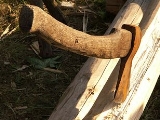
Axe
Encyclopedia
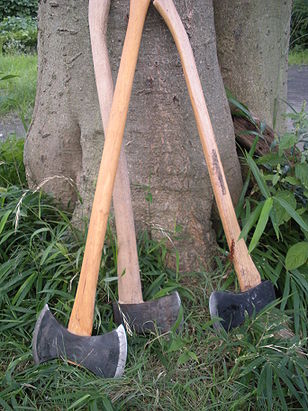
Millennium
A millennium is a period of time equal to one thousand years —from the Latin phrase , thousand, and , year—often but not necessarily related numerically to a particular dating system....
to shape, split and cut wood
Wood
Wood is a hard, fibrous tissue found in many trees. It has been used for hundreds of thousands of years for both fuel and as a construction material. It is an organic material, a natural composite of cellulose fibers embedded in a matrix of lignin which resists compression...
; to harvest
Harvest
Harvest is the process of gathering mature crops from the fields. Reaping is the cutting of grain or pulse for harvest, typically using a scythe, sickle, or reaper...
timber
Lumber
Lumber or timber is wood in any of its stages from felling through readiness for use as structural material for construction, or wood pulp for paper production....
; as a weapon
Weapon
A weapon, arm, or armament is a tool or instrument used with the aim of causing damage or harm to living beings or artificial structures or systems...
; and as a ceremonial
Ceremony
A ceremony is an event of ritual significance, performed on a special occasion. The word may be of Etruscan origin.-Ceremonial occasions:A ceremony may mark a rite of passage in a human life, marking the significance of, for example:* birth...
or heraldic
Heraldry
Heraldry is the profession, study, or art of creating, granting, and blazoning arms and ruling on questions of rank or protocol, as exercised by an officer of arms. Heraldry comes from Anglo-Norman herald, from the Germanic compound harja-waldaz, "army commander"...
symbol
Symbol
A symbol is something which represents an idea, a physical entity or a process but is distinct from it. The purpose of a symbol is to communicate meaning. For example, a red octagon may be a symbol for "STOP". On a map, a picture of a tent might represent a campsite. Numerals are symbols for...
. The axe has many forms and specialized uses but generally consists of an axe head with a handle
Handle (grip)
A handle is a part of, or attachment to, an object that can be moved or used by hand. The design of each type of handle involves substantial ergonomic issues, even where these are dealt with intuitively or by following tradition...
, or helve.
The earliest examples of axes have heads of stone
Rock (geology)
In geology, rock or stone is a naturally occurring solid aggregate of minerals and/or mineraloids.The Earth's outer solid layer, the lithosphere, is made of rock. In general rocks are of three types, namely, igneous, sedimentary, and metamorphic...
with some form of wooden handle attached (hafted
Hafting
Hafting is a process by which an artifact, often bone, metal, or stone, is attached to a handle or strap. This makes the artifact more useful by allowing it to be fired , thrown , or leveraged more effectively .Hafting is perhaps best known for its use by prehistoric man, but it is still practiced...
) in a method to suit the available materials and use. Axes made of copper
Copper
Copper is a chemical element with the symbol Cu and atomic number 29. It is a ductile metal with very high thermal and electrical conductivity. Pure copper is soft and malleable; an exposed surface has a reddish-orange tarnish...
, bronze
Bronze
Bronze is a metal alloy consisting primarily of copper, usually with tin as the main additive. It is hard and brittle, and it was particularly significant in antiquity, so much so that the Bronze Age was named after the metal...
, iron
Iron
Iron is a chemical element with the symbol Fe and atomic number 26. It is a metal in the first transition series. It is the most common element forming the planet Earth as a whole, forming much of Earth's outer and inner core. It is the fourth most common element in the Earth's crust...
, steel
Steel
Steel is an alloy that consists mostly of iron and has a carbon content between 0.2% and 2.1% by weight, depending on the grade. Carbon is the most common alloying material for iron, but various other alloying elements are used, such as manganese, chromium, vanadium, and tungsten...
appeared as these technologies developed.
The axe is an example of a simple machine
Simple machine
A simple machine is a mechanical device that changes the direction or magnitude of a force.In general, they can be defined as the simplest mechanisms that use mechanical advantage to multiply force. A simple machine uses a single applied force to do work against a single load force...
, as it is a type of wedge, or dual inclined plane
Inclined plane
The inclined plane is one of the original six simple machines; as the name suggests, it is a flat surface whose endpoints are at different heights. By moving an object up an inclined plane rather than completely vertical, the amount of force required is reduced, at the expense of increasing the...
. This reduces the effort needed by the wood chopper. It splits the wood into two parts by the pressure concentration at the blade. The handle of the axe also acts as a lever allowing the user to increase the force at the cutting edge—not using the full length of the handle is known as choking the axe. For fine chopping using a side axe this sometimes is a positive effect, but for felling
Felling
Felling is the name given to an area of land in eastern Gateshead, England. Originally an independent settlement in the historic county of Durham it became incorporated into the Metropolitan Borough of Gateshead in 1974....
with a double bitted axe it reduces efficiency.
Generally, cutting axes have a shallow wedge angle, whereas splitting axes have a deeper angle. Most axes are double beveled, i.e. symmetrical about the axis of the blade, but some specialist broadaxe
Broadaxe
A broadaxe is a large-headed axe. There were two types of broadaxes both used for shaping logs by hand hewing. On one type, one side is flat and the other side beveled, a basilled edge, this is a hewing broadaxe...
s have a single bevel blade, and usually an offset handle that allows them to be used for finishing work without putting the user's knuckles at risk of injury. Less common today, they were once an integral part of a joiner and carpenter's tool kit, not just a tool for use in forestry. A tool of similar origin is the billhook
Billhook
The billhook is a traditional cutting tool known and used throughout the world, and very common in the wine-growing countries of Europe, used widely in agriculture and forestry The billhook (also bill hook – although this more usually refers to either a metal or plastic hook used to hold bills,...
. However in France and Holland the billhook often replaced the axe as a joiner's bench tool.
Most modern axes have steel heads and wooden handles, typically hickory
Hickory
Trees in the genus Carya are commonly known as hickory, derived from the Powhatan language of Virginia. The genus includes 17–19 species of deciduous trees with pinnately compound leaves and big nuts...
in the US and ash
Ash tree
Fraxinus is a genus flowering plants in the olive and lilac family, Oleaceae. It contains 45-65 species of usually medium to large trees, mostly deciduous though a few subtropical species are evergreen. The tree's common English name, ash, goes back to the Old English æsc, while the generic name...
in Europe, although plastic
Plastic
A plastic material is any of a wide range of synthetic or semi-synthetic organic solids used in the manufacture of industrial products. Plastics are typically polymers of high molecular mass, and may contain other substances to improve performance and/or reduce production costs...
or fiberglass
Fiberglass
Glass fiber is a material consisting of numerous extremely fine fibers of glass.Glassmakers throughout history have experimented with glass fibers, but mass manufacture of glass fiber was only made possible with the invention of finer machine tooling...
handles are also common. Modern axes are specialized by use, size and form. Hafted axes with short handles designed for use with one hand are often called hand axes but the term hand axe refers to axes without handles as well. Hatchet
Hatchet
A hatchet is a single-handed striking tool with a sharp blade used to cut and split wood...
s tend to be small hafted axes often with a hammer
Hammer
A hammer is a tool meant to deliver an impact to an object. The most common uses are for driving nails, fitting parts, forging metal and breaking up objects. Hammers are often designed for a specific purpose, and vary widely in their shape and structure. The usual features are a handle and a head,...
on the back side ( the poll). As easy to make weapons, axes have frequently been used in combat.
History

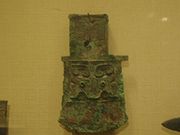
Mesolithic
The Mesolithic is an archaeological concept used to refer to certain groups of archaeological cultures defined as falling between the Paleolithic and the Neolithic....
period (ca. 6000 BC). Axes made from ground stone are known since the Neolithic
Neolithic
The Neolithic Age, Era, or Period, or New Stone Age, was a period in the development of human technology, beginning about 9500 BC in some parts of the Middle East, and later in other parts of the world. It is traditionally considered as the last part of the Stone Age...
. Few wooden hafts have been found from this period, but it seems that the axe was normally hafted by wedging. Birch-tar
Birch-tar
Birch-tar or birch-pitch is a substance derived from the dry distillation of the wood of the birch.- Compounds :It is compounded of guaiacol, phenols, cresol, xylenol, and creosol.- Uses :...
and raw-hide lashings were used to fix the blade.
Sometimes a short section of deer antler
Antler
Antlers are the usually large, branching bony appendages on the heads of most deer species.-Etymology:Antler originally meant the lowest tine, the "brow tine"...
(an "antler sleeve") was used, which prevented the splitting of the haft and softened the impact on the stone blade itself, helping absorb the impact of each axe blow and lessening the chances of breaking the handle. The antler was hollowed out at one end to create a socket for the axehead. The antler sheath was then either perforated and a handle inserted into it or set in a hole made in the handle instead.
The distribution of stone axes is an important indication of prehistoric trade. Thin sectioning is used to determine the provenance of the stone blades. In Europe, Neolithic 'axe factories', where thousands of ground stone axes were roughed out are known from many places, such as:
- Great Langdale, Great Britain (tuff)
- Rathlin Island, Ireland (porcellanite)
- KrzemionkiKrzemionkiKrzemionki, also Krzemionki Opatowskie - Neolithic and early Bronze Age complex of mines of the Upper Jurassic banded flints, located in the eastern Poland near Ostrowiec Świętokrzyski. It is the biggest complex of the prehistoric flint mines in Europe . .- History of mining :The mining area is...
, Poland (flint) - Plancher-les-Mines, France (pelite)
- Val de'Aoste, Italy (omphacite).
Stone axes are still produced and in use today in parts of Irian Jaya, New Guinea. The Mount Hagen area was an important production centre.
From the late Neolithic/Chalcolithic onwards, axes were made of copper or copper mixed with arsenic. These axes were flat and hafted much like their stone predecessors. Axes continued to be made in this manner with the introduction of Bronze metallurgy. Eventually the hafting method changed and the flat axe developed into the ‘flanged axe,’ then palstave
Palstave
A Palstave is a type of early bronze axe. It was common in the mid Bronze Age in north, western and south-western Europe. In the technical sense, although precise definitions differ, an axe is generally deemed to be a palstave if it is hafted by means of a forked wooden handle kept in place with...
s, and later winged and socketed axes.
The Proto-Indo-European word for "axe" may have been pelek'u- (Greek pelekus πέλεκυς, Sanskrit parashu, see also Parashurama
Parashurama
Parashurama , is the sixth avatar of Vishnu and belongs to the treta yuga, and is the son of a Brahmin father Jamadagni and mother Renuka. He is considered one of the seven immortal human. He received an axe after undertaking a terrible penance to please Shiva, from whom he learned the methods of...
), but the word was probably a loan, or a Neolithic wanderwort, ultimately related to Sumerian balag, Akkadian pilaku- .
Symbolism, ritual, and folklore
At least since the late Neolithic, elaborate axes (battle-axes, T-axes, etc.) had a religiousReligion
Religion is a collection of cultural systems, belief systems, and worldviews that establishes symbols that relate humanity to spirituality and, sometimes, to moral values. Many religions have narratives, symbols, traditions and sacred histories that are intended to give meaning to life or to...
significance and probably indicated the exalted status
Social status
In sociology or anthropology, social status is the honor or prestige attached to one's position in society . It may also refer to a rank or position that one holds in a group, for example son or daughter, playmate, pupil, etc....
of their owner. Certain types almost never show traces of wear; deposits of unshafted axe blades from the middle Neolithic (such as at the Somerset Levels
Somerset Levels
The Somerset Levels, or the Somerset Levels and Moors as they are less commonly but more correctly known, is a sparsely populated coastal plain and wetland area of central Somerset, South West England, between the Quantock and Mendip Hills...
in Britain) may have been gifts to the deities
Deity
A deity is a recognized preternatural or supernatural immortal being, who may be thought of as holy, divine, or sacred, held in high regard, and respected by believers....
.
In Minoan Crete, the double axe (labrys
Labrys
Labrys is the term for a symmetrical doubleheaded axe originally from Crete in Greece, one of the oldest symbols of Greek civilization; to the Romans, it was known as a bipennis....
) had a special significance, used by women priests in religious ceremonies. In 1998 a labrys, complete with an elaborately embellished haft, was found at Cham-Eslen, Canton of Zug
Canton of Zug
The Canton of Zug is one of the 26 cantons of Switzerland. It is located in central Switzerland and its capital is Zug. With 239 km² the canton is one of the smallest of the cantons in terms of area. It is not subdivided into districts.- History :The earlier history of the canton is...
, Switzerland
Switzerland
Switzerland name of one of the Swiss cantons. ; ; ; or ), in its full name the Swiss Confederation , is a federal republic consisting of 26 cantons, with Bern as the seat of the federal authorities. The country is situated in Western Europe,Or Central Europe depending on the definition....
. The haft was 120 cm long and wrapped in ornamented birch-bark. The axe blade is 17.4 cm long and made of antigorite, mined in the Gotthard-area. The haft goes through a biconical drilled hole and is fastened by wedges of antler and by birch-tar. It belongs to the early Cortaillod culture
Cortaillod culture
The Cortaillod culture is one of several archaeologically defined cultures belonging to the Neolithic period of Switzerland. The Cortaillod Culture in the west of the region is contemporary with the Pfyn Culture...
.
In the Roman
Ancient Rome
Ancient Rome was a thriving civilization that grew on the Italian Peninsula as early as the 8th century BC. Located along the Mediterranean Sea and centered on the city of Rome, it expanded to one of the largest empires in the ancient world....
fasces
Fasces
Fasces are a bundle of wooden sticks with an axe blade emerging from the center, which is an image that traditionally symbolizes summary power and jurisdiction, and/or "strength through unity"...
, the axe symbolized the authority
Authority
The word Authority is derived mainly from the Latin word auctoritas, meaning invention, advice, opinion, influence, or command. In English, the word 'authority' can be used to mean power given by the state or by academic knowledge of an area .-Authority in Philosophy:In...
to execute and were often used as symbols for Fascist Italy under Mussolini.
In folklore
Folklore
Folklore consists of legends, music, oral history, proverbs, jokes, popular beliefs, fairy tales and customs that are the traditions of a culture, subculture, or group. It is also the set of practices through which those expressive genres are shared. The study of folklore is sometimes called...
, stone axes were sometimes believed to be thunderbolt
Thunderbolt
A thunderbolt is a discharge of lightning accompanied by a loud thunderclap or its symbolic representation. In its original usage the word may also have been a description of meteors, or, as Plato suggested in Timaeus, of the consequences of a close approach between two planetary cosmic bodies,...
s and were used to guard buildings against lightning
Lightning
Lightning is an atmospheric electrostatic discharge accompanied by thunder, which typically occurs during thunderstorms, and sometimes during volcanic eruptions or dust storms...
, as it was believed (mythically
Rumor
A rumor or rumour is often viewed as "an unverified account or explanation of events circulating from person to person and pertaining to an object, event, or issue in public concern" However, a review of the research on rumor conducted by Pendleton in 1998 found that research across sociology,...
) that lightning never struck the same place twice. This has caused some skewing of axe distributions.
Steel
Steel
Steel is an alloy that consists mostly of iron and has a carbon content between 0.2% and 2.1% by weight, depending on the grade. Carbon is the most common alloying material for iron, but various other alloying elements are used, such as manganese, chromium, vanadium, and tungsten...
axes were important in superstition
Superstition
Superstition is a belief in supernatural causality: that one event leads to the cause of another without any process in the physical world linking the two events....
as well. A thrown axe could keep off a hail
Hail
Hail is a form of solid precipitation. It consists of balls or irregular lumps of ice, each of which is referred to as a hail stone. Hail stones on Earth consist mostly of water ice and measure between and in diameter, with the larger stones coming from severe thunderstorms...
storm, sometimes an axe was placed in the crops
Crop (agriculture)
A crop is a non-animal species or variety that is grown to be harvested as food, livestock fodder, fuel or for any other economic purpose. Major world crops include maize , wheat, rice, soybeans, hay, potatoes and cotton. While the term "crop" most commonly refers to plants, it can also include...
, with the cutting edge to the skies to protect the harvest against bad weather
Weather
Weather is the state of the atmosphere, to the degree that it is hot or cold, wet or dry, calm or stormy, clear or cloudy. Most weather phenomena occur in the troposphere, just below the stratosphere. Weather refers, generally, to day-to-day temperature and precipitation activity, whereas climate...
. An upright axe buried under the sill
Sill plate
A sill plate or sole plate in construction and architecture is the bottom horizontal member of a wall or building to which vertical members are attached. Sill plates are usually composed of lumber. It usually comes in sizes of 2×4, 2×6, 2×8, and 2×10. In the platform framing method the sill plate...
of a house would keep off witches
Witchcraft
Witchcraft, in historical, anthropological, religious, and mythological contexts, is the alleged use of supernatural or magical powers. A witch is a practitioner of witchcraft...
, while an axe under the bed would assure male
Male
Male refers to the biological sex of an organism, or part of an organism, which produces small mobile gametes, called spermatozoa. Each spermatozoon can fuse with a larger female gamete or ovum, in the process of fertilization...
offspring
Offspring
In biology, offspring is the product of reproduction, of a new organism produced by one or more parents.Collective offspring may be known as a brood or progeny in a more general way...
.
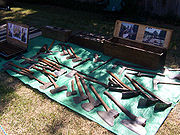
Basque people
The Basques as an ethnic group, primarily inhabit an area traditionally known as the Basque Country , a region that is located around the western end of the Pyrenees on the coast of the Bay of Biscay and straddles parts of north-central Spain and south-western France.The Basques are known in the...
, Australia
Australia
Australia , officially the Commonwealth of Australia, is a country in the Southern Hemisphere comprising the mainland of the Australian continent, the island of Tasmania, and numerous smaller islands in the Indian and Pacific Oceans. It is the world's sixth-largest country by total area...
ns and New Zealanders have developed variants of rural sports that perpetuate the traditions of log cutting with axe. The Basque variants, splitting horizontally or vertically disposed logs, are generically called aizkolaritza
Aizkolaritza
Aizkolaritza is the Basque name for a type of wood-chopping competition. They are a popular form of herri kirol in the Basque Country...
(from aizkora: axe).
In Yorùbá mythology, the oshe (double-headed axe) symbolizes Shango
Shango
In the Yorùbá religion, Sàngó is perhaps one of the most popular Orisha; also known as the god of fire, lightning and thunder...
, Orisha
Orisha
An Orisha is a spirit or deity that reflects one of the manifestations of Olodumare in the Yoruba spiritual or religious system....
(god) of thunder and lightning. It is said to represent swift and balanced justice. Shango altars often contain a carved figure of a woman holding a gift to the god with a double-bladed axe sticking up from her head.
Parts of the axe
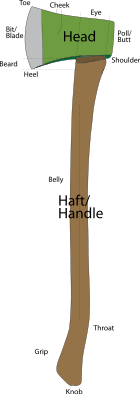
The axe head is typically bounded by the bit (or blade) at one end, and the poll (or butt) at the other, though some designs feature two bits opposite each other. The top corner of the bit where the cutting edge begins is called the toe, and the bottom corner is known as the heel. Either side of the head is called the cheek, which is sometimes supplemented by lugs where the head meets the haft, and the hole where the haft is mounted is called the eye. The part of the bit that descends below the rest of the axe-head is called the beard, and a bearded axe is an antiquated axe head with an exaggerated beard that can sometimes extend the cutting edge twice the height of the rest of the head.
The axe haft is sometimes called the handle. Traditionally, it was made of a resilient hardwood like hickory or ash, but modern axes often have hafts made of durable synthetic materials. Antique axes and their modern reproductions, like the tomahawk
Tomahawk (axe)
A tomahawk is a type of axe native to North America, traditionally resembling a hatchet with a straight shaft. The name came into the English language in the 17th century as a transliteration of the Powhatan word.Tomahawks were general purpose tools used by Native Americans and European Colonials...
, often had a simple, straight haft with a circular cross-section that wedged onto the axe-head without the aid of wedges or pins. Modern hafts are curved for better grip and to aid in the swinging motion, and are mounted securely to the head. The shoulder is where the head mounts onto the haft, and this is either a long oval or rectangular cross-section of the haft that's secured to the axe head with small metal or wooden wedges. The belly of the haft is the longest part, where it bows in gently, and the throat is where it curves sharply down into to the short grip, just before end of the haft, which is known as the knob.
Axes designed to cut or shape wood

- Felling axe – Cuts across the grain of wood, as in the fellingFellingFelling is the name given to an area of land in eastern Gateshead, England. Originally an independent settlement in the historic county of Durham it became incorporated into the Metropolitan Borough of Gateshead in 1974....
of trees. In single or double bit (the bit is the cutting edge of the head) forms and many different weights, shapes, handle types and cutting geometries to match the characteristics of the material being cut. More so than with for instance a splitting axe, the bit of a felling axe needs to be very sharp, to be able to efficiently cut the fibres. - Splitting axe – Used to split with the grain of the wood. Splitting axe bits are more wedge shaped. This shape causes the axe to rend the fibres of the wood apart, without having to cut through them.
- Broad axeBroadaxeA broadaxe is a large-headed axe. There were two types of broadaxes both used for shaping logs by hand hewing. On one type, one side is flat and the other side beveled, a basilled edge, this is a hewing broadaxe...
– Used with the grain of the wood in precision splitting or "hewingHewingHewing is the process of converting sections of a tree stem from its rounded natural form into a form with more or less flat surfaces using primarily, among other tools, an axe or axes...
" (i.e. the squaring-off of round timbers usually for use in construction). Broad axe bits are most commonly chiselChiselA chisel is a tool with a characteristically shaped cutting edge of blade on its end, for carving or cutting a hard material such as wood, stone, or metal. The handle and blade of some types of chisel are made of metal or wood with a sharp edge in it.In use, the chisel is forced into the material...
-shaped (i.e. one flat and one beveled edge) facilitating more controlled work as the flat cheek passes across the squared timber. - AdzeAdzeAn adze is a tool used for smoothing or carving rough-cut wood in hand woodworking. Generally, the user stands astride a board or log and swings the adze downwards towards his feet, chipping off pieces of wood, moving backwards as they go and leaving a relatively smooth surface behind...
– A variation featuring a head perpendicular to that of an axe. Rather than splitting wood side-by-side, it is used to rip a level surface into a horizontal piece of wood. - HatchetHatchetA hatchet is a single-handed striking tool with a sharp blade used to cut and split wood...
– A small, light axe designed for use in one hand specifically while camping or travelling. - Hand axe – A small axe used for intermediate chopping, similar to hatchets.
- MortisingMortise and tenonThe mortise and tenon joint has been used for thousands of years by woodworkers around the world to join pieces of wood, mainly when the adjoining pieces connect at an angle of 90°. In its basic form it is both simple and strong. Although there are many joint variations, the basic mortise and tenon...
Axe - Used for creating mortises, a process which begins by drilling two holes at the ends of the intended mortise. Then the wood between the holes is removed with the mortising axe. Some forms of the tool have one blade, which may be pushed, swung or struck with a mallet. Others, such as twybil, bisaigüe and piochon have two, one of which is used for separating the fibres, and the other for levering out the waste.
Axes as weapons
- Battle axeBattle axeA battle axe is an axe specifically designed for combat. Battle axes were specialized versions of utility axes...
– In its most common form, an arm-length weapon borne in one or both hands. Compared to a swordSwordA sword is a bladed weapon used primarily for cutting or thrusting. The precise definition of the term varies with the historical epoch or the geographical region under consideration...
swing, it delivers more cleaving power against a smaller target area, making it more effective against armor, due to concentrating more of its weight in the axehead. However, it allows much less precision than a sword does.

- TomahawkTomahawk (axe)A tomahawk is a type of axe native to North America, traditionally resembling a hatchet with a straight shaft. The name came into the English language in the 17th century as a transliteration of the Powhatan word.Tomahawks were general purpose tools used by Native Americans and European Colonials...
– used almost exclusively by Native AmericansIndigenous peoples of the AmericasThe indigenous peoples of the Americas are the pre-Columbian inhabitants of North and South America, their descendants and other ethnic groups who are identified with those peoples. Indigenous peoples are known in Canada as Aboriginal peoples, and in the United States as Native Americans...
, its blade was originally crafted of stone. Along with the familiar war version, which could be fashioned as a throwing weapon, the pipe tomahawk was a ceremonial and diplomatic tool. A similar type of axe is the African nzappa zapNzappa zapThe Nzappa zap is a traditional African weapon similar to an axe or hatchet. It has an ornate wrought-iron blade connected to a club-like wooden handle, often clad in copper, bronze or brass. In practice, it is used much like the American tomahawk, both thrown for short distances and as a melee...
. Tomahawks have made a resurgence among US military forces. - Spontoon Tomahawk – A French trapper and Iroquois collaboration, this was an axe with a knife-like stabbing blade instead of the familiar wedged shape.
- Shepherd's axe – used by shepherds in the Carpathian MountainsCarpathian MountainsThe Carpathian Mountains or Carpathians are a range of mountains forming an arc roughly long across Central and Eastern Europe, making them the second-longest mountain range in Europe...
, it could double as a walking stickWalking stickA walking stick is a device used by many people to facilitate balancing while walking.Walking sticks come in many shapes and sizes, and can be sought by collectors. Some kinds of walking stick may be used by people with disabilities as a crutch...
. - OnoOno (weapon)is the Japanese word for an "axe" or a "hatchet", and is used to describe various tools of similar structure. As with axes in other cultures, ono are sometimes employed as weapons. The few existing academic references and documented examples of this particular weapon are in connection with the...
– a JapaneseJapanese peopleThe are an ethnic group originating in the Japanese archipelago and are the predominant ethnic group of Japan. Worldwide, approximately 130 million people are of Japanese descent; of these, approximately 127 million are residents of Japan. People of Japanese ancestry who live in other countries...
weapon wielded by sōheiSoheiwere Buddhist warrior monks of feudal Japan. At certain points of history they held considerable power, obliging the imperial and military governments to collaborate....
warrior monks. - Dagger-axeDagger-axeThe dagger-axe is a type of weapon that was in use from Shang dynasty until at least Han dynasty China. It consists of a dagger-shaped blade made of jade , bronze, or later iron, mounted by the tang of the dagger to a perpendicular wooden shaft with a spear point...
(Ji or Ge) – A variant of Chinese spearSpearA spear is a pole weapon consisting of a shaft, usually of wood, with a pointed head.The head may be simply the sharpened end of the shaft itself, as is the case with bamboo spears, or it may be made of a more durable material fastened to the shaft, such as flint, obsidian, iron, steel or...
like weapon with a divided two-part head, consisting of the usual straight blade and a scythe-like blade. The straight blade is used to stab or feint, then the foe's body or head may be cut by pulling the scythe-like horizontal blade backwards. Ge has the horizontal blade but does not have the straight spear. - HalberdHalberdA halberd is a two-handed pole weapon that came to prominent use during the 14th and 15th centuries. Possibly the word halberd comes from the German words Halm , and Barte - in modern-day German, the weapon is called Hellebarde. The halberd consists of an axe blade topped with a spike mounted on...
– a spearSpearA spear is a pole weapon consisting of a shaft, usually of wood, with a pointed head.The head may be simply the sharpened end of the shaft itself, as is the case with bamboo spears, or it may be made of a more durable material fastened to the shaft, such as flint, obsidian, iron, steel or...
like weapon with a hooked poll, effective against mounted cavalryCavalryCavalry or horsemen were soldiers or warriors who fought mounted on horseback. Cavalry were historically the third oldest and the most mobile of the combat arms...
. - Pole axe – designed to defeat plate armourPlate armourPlate armour is a historical type of personal armour made from iron or steel plates.While there are early predecessors such the Roman-era lorica segmentata, full plate armour developed in Europe during the Late Middle Ages, especially in the context of the Hundred Years' War, from the coat of...
. Its axe (or hammer) head is much narrower than other axes, which accounts for its penetrating power. - Danish axe – A long-handled weapon with a large flat blade, often attributed to the VikingVikingThe term Viking is customarily used to refer to the Norse explorers, warriors, merchants, and pirates who raided, traded, explored and settled in wide areas of Europe, Asia and the North Atlantic islands from the late 8th to the mid-11th century.These Norsemen used their famed longships to...
s.
- Throwing axeThrowing axeA throwing axe is an axe that is used primarily as a missile weapon. Usually, they are thrown in an overhand motion in a manner that causes the axe to rotate as it travels through the air. Throwing axes have been used since prehistoric times and were developed into the Francisca by the Franks in...
– Any of a number of ranged weaponRanged weaponA ranged weapon is any weapon that can harm targets at distances greater than hand-to-hand distance. In contrast, a weapon intended to be used in man-to-man combat is called a melee weapon....
s designed to strike with a similar splitting action as their MêléeMêlée weaponA melee weapon is any weapon that does not involve a projectile — that is, both the user and target of the weapon are in contact with it simultaneously in normal use...
counterparts. These are often small in profile and usable with one hand. - HurlbatHurlbatA hurlbat or whirlbat is a ranged weapon consisting of an entirely metal throwing axe sharpened on every auxiliary end to a point or blade, greatly increasing the chance of some form of damage against its target. They are usually constructed from six millimeter thick steel, which makes them...
– An entirely metal throwing axe sharpened on every auxiliary end to a point or blade, practically guaranteeing some form of damage against its target. - FranciscaFranciscaThe francisca is a throwing axe used as a weapon during the Early Middle Ages by the Franks, among whom it was a characteristic national weapon at the time of the Merovingians from about 500 to 750 AD and is known to have been used during the reign of Charlemagne .Although generally associated...
or Frankish axe – a short throwing weapon of the European Migration PeriodMigration PeriodThe Migration Period, also called the Barbarian Invasions , was a period of intensified human migration in Europe that occurred from c. 400 to 800 CE. This period marked the transition from Late Antiquity to the Early Middle Ages...
, the name of which may have become attached to the Germanic tribe associated with it: the FranksFranksThe Franks were a confederation of Germanic tribes first attested in the third century AD as living north and east of the Lower Rhine River. From the third to fifth centuries some Franks raided Roman territory while other Franks joined the Roman troops in Gaul. Only the Salian Franks formed a...
(see FranceFranceThe French Republic , The French Republic , The French Republic , (commonly known as France , is a unitary semi-presidential republic in Western Europe with several overseas territories and islands located on other continents and in the Indian, Pacific, and Atlantic oceans. Metropolitan France...
). - Parashu - The parashu is an IndiaIndiaIndia , officially the Republic of India , is a country in South Asia. It is the seventh-largest country by geographical area, the second-most populous country with over 1.2 billion people, and the most populous democracy in the world...
n battle-axe. It is generally wielded with two hands but could also be used with only one.
Axes as tools
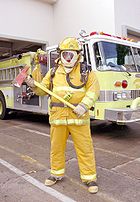
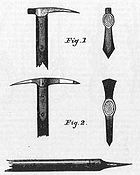
- FirefighterFirefighterFirefighters are rescuers extensively trained primarily to put out hazardous fires that threaten civilian populations and property, to rescue people from car incidents, collapsed and burning buildings and other such situations...
's axe or fire axe – It has a pick-shaped pointed poll (area of the head opposite the cutting edge). It is often decorated in vivid colors to make it easily visible during an emergency. Its primary use is for breaking down doors and windows. - PulaskiPulaski (tool)The pulaski is a special hand tool used in wildland firefighting.The tool combines an axe and an adze in one head, similar to that of the cutter mattock, with a rigid handle of wood, plastic, or fiberglass. The pulaski is a versatile tool for constructing firebreaks, as it can be used to both dig...
– An axe with a mattockMattockA mattock is a versatile hand tool, used for digging and chopping, similar to the pickaxe. It has a long handle, and a stout head, which combines an axe blade and an adze or a pick and an adze .-Description:...
blade built into the rear of the main axe blade, used for digging ('grubbing out') through and around roots as well as chopping. In addition to the McCloud (a tool similar to a hoe/rake combination), the pulaski is an indispensable tool used in fighting forest firesWildfireA wildfire is any uncontrolled fire in combustible vegetation that occurs in the countryside or a wilderness area. Other names such as brush fire, bushfire, forest fire, desert fire, grass fire, hill fire, squirrel fire, vegetation fire, veldfire, and wilkjjofire may be used to describe the same...
, as well as trail-building, brush clearance and similar functions. - Splitting maul – A splitting implement that has evolved from the simple 'wedge' design to more complex designs. Some mauls have a conical 'axehead'; compound mauls have swiveling 'sub-wedges', among other types; others have a heavy wedge-shaped head, with a sledgehammerSledgehammerA sledgehammer is a tool consisting of a large, flat head attached to a lever . The head is typically made of metal. The sledgehammer can apply more impulse than other hammers, due to its large size. Along with the mallet, it shares the ability to distribute force over a wide area...
face opposite. - Slater's axeSlaterSlater is an occupational surname of English origin. A slater is a tradesman.-Surname:* Allana Slater , Australian artistic gymnast* Bert Slater , Scottish football player* Bill Slater , English footballer...
– An axe for cutting roofing slateSlateSlate is a fine-grained, foliated, homogeneous metamorphic rock derived from an original shale-type sedimentary rock composed of clay or volcanic ash through low-grade regional metamorphism. The result is a foliated rock in which the foliation may not correspond to the original sedimentary layering...
, with a long point on the poll for punching nail holes, and with the blade offset laterally from the handle to protect the worker's hand from flying slate chips. - Ice axeIce axeAn ice axe, is a multi-purpose ice and snow tool used by mountaineers both in the ascent and descent of routes which involve frozen conditions. It can be held and employed in a number of different ways, depending on the terrain encountered...
or climbing axe – A number of different styles of ice axes are designed for ice climbingIce climbingIce climbing, as the term indicates, is the activity of ascending inclined ice formations. Usually, ice climbing refers to roped and protected climbing of features such as icefalls, frozen waterfalls, and cliffs and rock slabs covered with ice refrozen from flows of water. For the purposes of...
and enlarging steps used by climbers.
Hammer axe
Hammer axes (or axe-hammers) typically feature an extended pole, opposite the blade, shaped and sometimes hardened for use as a hammerHammer
A hammer is a tool meant to deliver an impact to an object. The most common uses are for driving nails, fitting parts, forging metal and breaking up objects. Hammers are often designed for a specific purpose, and vary widely in their shape and structure. The usual features are a handle and a head,...
. The name axe-hammer is often applied to a characteristic shape of perforated stone axe used in the Neolithic
Neolithic
The Neolithic Age, Era, or Period, or New Stone Age, was a period in the development of human technology, beginning about 9500 BC in some parts of the Middle East, and later in other parts of the world. It is traditionally considered as the last part of the Stone Age...
and Bronze Age
Bronze Age
The Bronze Age is a period characterized by the use of copper and its alloy bronze as the chief hard materials in the manufacture of some implements and weapons. Chronologically, it stands between the Stone Age and Iron Age...
s. Iron axe-hammers are found in Roman military contexts, e.g. Cramond
Cramond
Cramond is a seaside village now part of suburban Edinburgh, Scotland, located in the north-west corner of the city at the mouth of the River Almond where it enters the Firth of Forth....
, Edinburgh
Edinburgh
Edinburgh is the capital city of Scotland, the second largest city in Scotland, and the eighth most populous in the United Kingdom. The City of Edinburgh Council governs one of Scotland's 32 local government council areas. The council area includes urban Edinburgh and a rural area...
and South Shields
South Shields
South Shields is a coastal town in Tyne and Wear, England, located at the mouth of the River Tyne to Tyne Dock, and about downstream from Newcastle upon Tyne...
, Tyne and Wear
Tyne and Wear
Tyne and Wear is a metropolitan county in north east England around the mouths of the Rivers Tyne and Wear. It came into existence as a metropolitan county in 1974 after the passage of the Local Government Act 1972...
.
Today they are used in many different fields of work, completing all jobs from splitting wood to removing engines from vans. Tungsten
Tungsten
Tungsten , also known as wolfram , is a chemical element with the chemical symbol W and atomic number 74.A hard, rare metal under standard conditions when uncombined, tungsten is found naturally on Earth only in chemical compounds. It was identified as a new element in 1781, and first isolated as...
is often added for weight as an upgrade, as well as six foot handles for the heavier jobs that require added force and "massive blows" such as cutting automobile frames, slicing brake rotors, rough body work, home construction, home de-construction, etc.
See also
- SagarisSagarisSagaris is the ancient Greek name for a shafted weapon used by the horse-riding ancient North-Iranian Saka and Scythian peoples of the great Eurasian steppe, also by the Western and Central Asian peoples: the Medes, Persians, Parthayans, Indo-Saka, Kushans, Tocharians...
- FascesFascesFasces are a bundle of wooden sticks with an axe blade emerging from the center, which is an image that traditionally symbolizes summary power and jurisdiction, and/or "strength through unity"...
- Battle axe peopleCorded Ware cultureThe Corded Ware culture , alternatively characterized as the Battle Axe culture or Single Grave culture, is an enormous European archaeological horizon that begins in the late Neolithic , flourishes through the Copper Age and culminates in the early Bronze Age.Corded Ware culture is associated with...
Corded Ware culture - Nzappa zapNzappa zapThe Nzappa zap is a traditional African weapon similar to an axe or hatchet. It has an ornate wrought-iron blade connected to a club-like wooden handle, often clad in copper, bronze or brass. In practice, it is used much like the American tomahawk, both thrown for short distances and as a melee...
Related Forestry Terms:
- Chain saw
- FellingFellingFelling is the name given to an area of land in eastern Gateshead, England. Originally an independent settlement in the historic county of Durham it became incorporated into the Metropolitan Borough of Gateshead in 1974....
- HewingHewingHewing is the process of converting sections of a tree stem from its rounded natural form into a form with more or less flat surfaces using primarily, among other tools, an axe or axes...
- Limbing
- LoggingLoggingLogging is the cutting, skidding, on-site processing, and loading of trees or logs onto trucks.In forestry, the term logging is sometimes used in a narrow sense concerning the logistics of moving wood from the stump to somewhere outside the forest, usually a sawmill or a lumber yard...
- Log buckingLog buckingthumb|right|Bucker measuring and swamping or knot bumpingthumb|right|Bucker - Making the CutBucking is the process of cutting a felled and delimbed tree into logs...
- Splitting maul
- Wood splitter
Neolithic axes
- W. Borkowski, Krzemionki mining complex (Warszawa 1995)
- P. Pétrequin, La hache de pierre: carrières vosgiennes et échanges de lames polies pendant le néolithique (5400 - 2100 av. J.-C.) (exposition musées d'Auxerre Musée d'Art et d'Histoire) (Paris, Ed. Errance, 1995).
- R. Bradley/M. Edmonds, Interpreting the axe trade: production and exchange in Neolithic Britain (1993).
- P. Pétrequin/A.M. Pétrequin, Écologie d'un outil: la hache de pierre en Irian Jaya (Indonésie). CNRS Éditions, Mongr. du Centre Rech. Arch. 12 (Paris 1993).
Medieval axes
- Schulze, André(Hrsg.): Mittelalterliche Kampfesweisen. Band 2: Kriegshammer, Schild und Kolben. - Mainz am Rhein. : Zabern, 2007. - ISBN 3-8053-3736-1
Superstition
- H. Bächtold-Stäubli, Handwörterbuch des deutschen Aberglaubens (Berlin, De Gruyter 1987).

